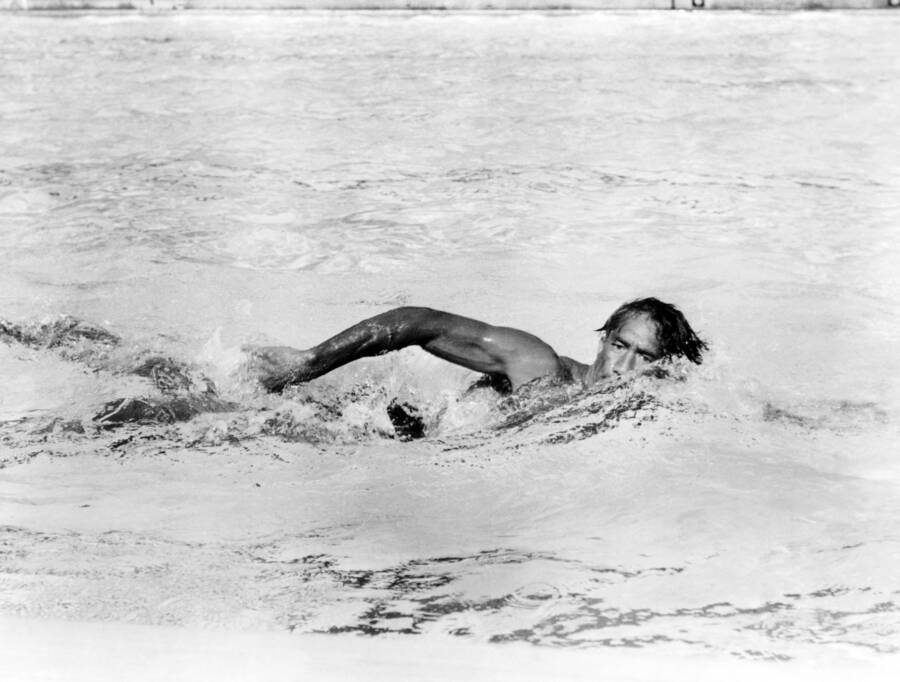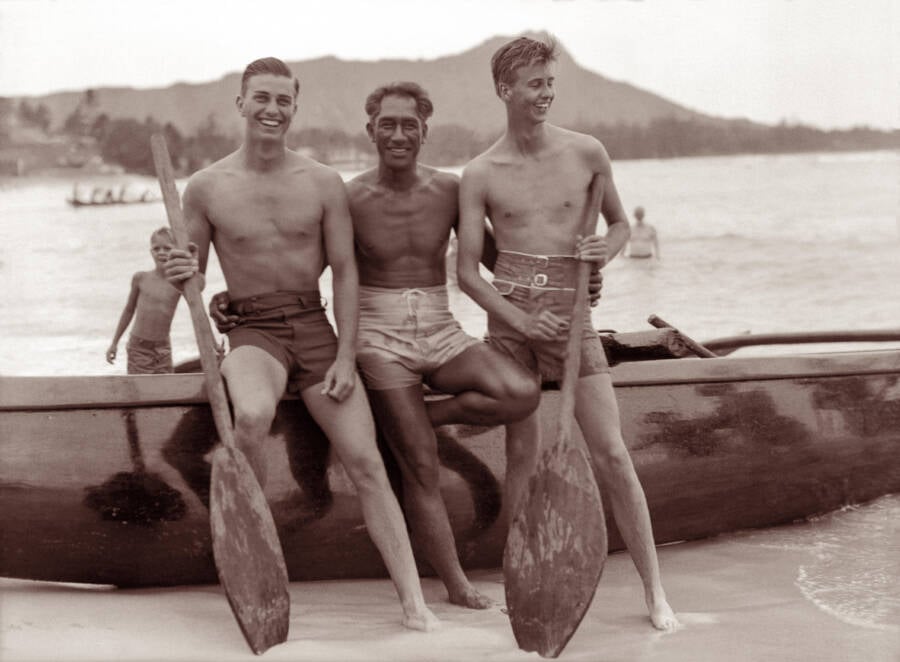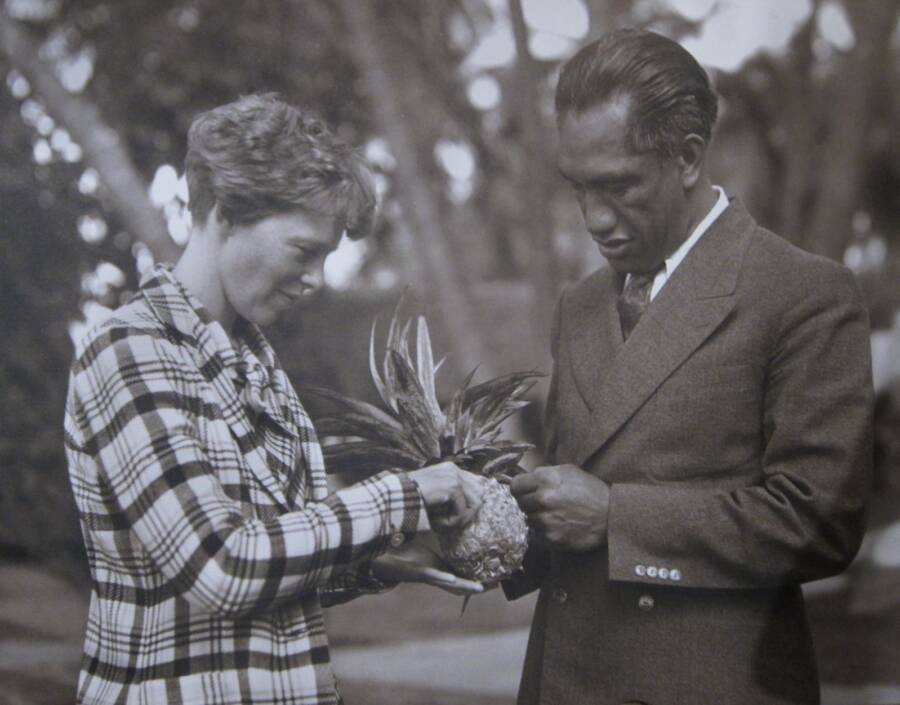In the early 20th century, Olympic gold medal-winning swimmer Duke Kahanamoku held surfing exhibitions around the world, popularizing the sport in California and Australia.

Alpha Historica / Alamy Stock PhotoDuke Kahanamoku, the Olympic gold medalist and father of modern surfing.
If anyone should be credited with introducing the Hawaiian tradition of surfing to the masses, it’s Duke Kahanamoku. He grew up on the outskirts of Waikiki, where he first fell in love with surfing. Eventually, he popularized the sport from the California coast to Australia and New Zealand, inspiring generations of surfers to follow in his footsteps.
But Kahanamoku wasn’t just a renowned surfer. He was also a champion swimmer who broke several world records. Between 1912 and 1924, he won three gold and two silver medals for the United States at the Olympics.
Even outside of the world of sports, Kahanamoku proved himself time and time again as a leader and hero, from serving as the sheriff of Honolulu to rescuing eight drowning men with his surfboard after their boat capsized. His natural charisma and talent also saw him cast in several Hollywood films, introducing the “Ambassador of Aloha” to audiences beyond the coast.
It’s little wonder why Duke Kahanamoku is considered a legend: He embodied the word to the fullest.
Duke Kahanamoku’s Early Years Growing Up In Waikiki
Duke Kahanamoku was born on Aug. 24, 1890, just three years before the overthrow of the Hawaiian Kingdom.
Growing up on the beaches of Waikiki, it was clear early on that the young Kahanamoku was a natural in the water. According to his official website, Kahanamoku learned during this time that he preferred to use a traditional surfboard made of native koa wood — one that measured 16 feet in length and weighed 114 pounds.

Public DomainDuke Kahanamoku with his traditional surfboard.
He continued to hone his skills, both in swimming and in wave-riding, gracefully navigating the powerful Pacific swells around the island. Kahanamoku first gained international attention in the world of competitive swimming when he broke the world record for the 100-yard freestyle by a stunning 4.6 seconds in 1911.
It was such an unbelievable feat, in fact, that some officials initially refused to believe it. But his talent was undeniable, and he quickly became a sensation. From there, Kahanamoku set his sights on an even greater achievement: the Olympic Games.
Becoming An Olympic Gold Medal-Winning Swimmer
Many athletes dream of competing in the Olympics, but the road to even qualifying for the competition can be long and fierce. Many who make it that far leave without taking home a medal, let alone the gold. In 1912, though, Duke Kahanamoku proved just how much he excelled in his sport.
At the 1912 Stockholm Games, Kahanamoku claimed his first gold medal in the 100-meter freestyle and a silver in the 4×200-meter freestyle relay. The world took notice of this powerful, graceful swimmer from the Pacific whose unique “Kahanamoku kick” — a strong, alternating leg kick — was both revolutionary and highly effective.

Everett Collection Inc / Alamy Stock PhotoDuke Kahanamoku swimming in Los Angeles as he prepares to compete at the 1932 Olympics.
Several contemporary accounts archived by the Hawai’i Digital Newspaper Project offer insight into how Kahanamoku’s presence captivated those who watched him. “Kanaka Swimmer Has No Equal in the Water: This Hawaiian a Human Fish,” read the headline of one Salt Lake City newspaper. The paper goes on to describe how train passengers who observed Kahanamoku surfing as a boy would toss coins out to him, which he would catch in his mouth.
The New York Tribune described his strokes and kicks as “perfection” and a “poetry of motion,” and Kahanamoku told The Evening World around the same time that he wasn’t sure if he had learned to walk or swim first as a young child. He also emphasized his appreciation of traditional Hawaiian ways, telling the outlet, “I have no doubt the ancient Hawaiians used every stroke we know and perhaps had better swimming form than we’ll ever have.”
At the Antwerp Olympics in 1920, Duke Kahanamoku won two more gold medals — one for the 100-meter freestyle and another for the relay. By the 1924 Paris Olympics, at nearly 34 years old, he still managed to win a silver medal in the 100-meter freestyle, only narrowly being beaten by his younger, equally talented teammate, Johnny Weissmuller (who would later gain fame as Tarzan). According to the Sports Gazette, Kahanamoku had told Weismuller before the race, “Hey, the most important thing in this race is to get the American flag up there three times. Let’s do it.”
They succeeded, with Kahanamoku’s brother Samuel taking the bronze medal.
Winning silver proved that Kahanamoku could still compete, a testament to his dedication and skill, but it was his humility that endeared him to people across the world. And of course, his Olympic career cemented his place in history as one of the greatest swimmers of his era.
But in between those competitions, Kahanamoku was busy doing something else entirely, something that would have a far more profound and lasting global impact: popularizing the ancient Hawaiian sport of surfing.
How The Ambassador Of Aloha Brought Surfing To The Rest Of The World

Alpha Historica / Alamy Stock PhotoDuke Kahanamoku with President Franklin D. Roosevelt’s sons, FDR Jr. and John Roosevelt, at Waikiki Beach during the first official presidential trip to the territory in 1934.
To Kahanamoku, and to many others who practiced the sport, surfing was more than just a pastime. It was a connection to Hawaiian culture, a way of life, and a joyful expression of human interaction with the ocean.
So, starting in the early 1910s, Kahanamoku traveled extensively, initially to the United States, then to Australia and New Zealand. His “demonstration tours” were the stuff of legend. He would arrive in a new city, often greeted by curious crowds, and then paddle out on his heavy, traditional board, riding waves with a captivating blend of power and artistry. His charisma was infectious, his smile genuine, and his passion for surfing undeniable.
When he demonstrated surfing at Sydney’s Freshwater Beach in 1914, it became what many consider to be the modern genesis of surfing in Australia. Kahanamoku shaped a board from local timber and invited locals to try it, effectively planting the seeds of what would become a national obsession.
He did the same in California, where he also lived for periods throughout his life, and helped establish the still prominent surfing culture there. But for Duke Kahanamoku, this wasn’t about showing off. In teaching others how to surf, he was sharing a piece of his heritage and igniting a spark in people around the world, proving that this ancient sport could be enjoyed by all. It was for this reason that he came to be known as the “Ambassador of Aloha,” spreading the spirit of his homeland with every wave he rode and every smile he shared.
Understandably, Kahanamoku also strongly advocated for the inclusion of surfing in the Olympics throughout his life. Although he didn’t live to see it happen, that dream did ultimately come true during the 2020 Tokyo Olympics, when his beloved sport made its debut.
Then, a year after his silver medal win at the Paris Olympics, Kahanamoku showcased his surfing ability once more — though this time, it wasn’t meant to be a demonstration.
Per a TIME report, in 1925, the fishing vessel Thelma capsized near Laguna Beach. Onlookers confident in their swimming ability dove into the water to try and rescue the drowning fishermen, and at the front of the group was none other than Duke Kahanamoku, pushing his surfboard ahead of him.
Five fishermen could not be saved, but working with the other swimmers, Kahanamoku was able to rescue eight men by pulling one onto his board, paddling him to safety, and returning to grab another. His fellow rescuers managed to save an additional five drowning men, for a total of 13 survivors. It was a heroic feat, to be sure, and it escalated an already renowned figure to the status of a true legend.
From Hollywood Actor To Honolulu Sheriff: The Later Life Of Duke Kahanamoku

Alto Vintage Images / Alamy Stock PhotoAmelia Earhart and Duke Kahanamoku in Hawaii in late 1934 or early 1935.
Outside of swimming at the Olympics, spreading surfing around the world, and saving lives, Duke Kahanamoku appeared in more than a dozen Hollywood films, often playing roles that capitalized on his athletic physique and good looks. While the parts were usually stereotypical, they did contribute to elevating his public profile and continuing his role as a Hawaiian ambassador.
But as he got older, Kahanamoku sought to return to the islands he called home. Between the years of 1932 and 1961, he served as the sheriff of Honolulu, winning re-election 13 times — a clear sign that the people of Hawaii held a deep respect for him. Over the course of nearly three decades, he continued to embody the spirit of aloha, welcoming dignitaries and tourists to the islands, always with a warm smile and a handshake. He was, in essence, Hawaii’s unofficial greeter to the world.
Duke Kahanamoku passed away on Jan. 22, 1968, at the age of 77, but he left behind an eternal legacy. He is revered as the “Father of Modern Surfing,” inducted into both the International Swimming Hall of Fame and the International Surfing Hall of Fame.
More than anything else, though, Duke Kahanamoku’s legacy is more than just his athletic accomplishments. He was a bridge between cultures, a pioneer who broke racial barriers, and a living embodiment of the aloha spirit. He showed the world the beauty of Hawaii, its people, and its ancient customs, all through the thrill of riding the waves.
After reading about the remarkable life of Duke Kahanamoku, learn about Ettore Boiardi, the man who became known as “Chef Boyardee.” Then, go inside the story of the 1904 Olympic Marathon that was so disastrous it nearly got the sport banned.





